
~~~~~~~~~~~~~~~~~~~~~~~~~~~~~~~~~~~~~~~~~~~
Live Earth Farm (Com)Post
5th Harvest Week, Season 13
May 5th - 11th, 2008
~~~~~~~~~~~~~~~~~~~~~~~~~~~~~~~~~~~~~~~~~~~
In this issue
--Greetings from Farmer Tom
--What's Up in the Field
--Live Earth Farm Kids
--Mataganza Garden Sanctuary Open House and Fundraiser
--Pictures around the farm
--What's in the box this week
--Notes from Debbie's Kitchen
--Calendar of Events
--Contact Information
" The course of true love never did run smooth."
~
William Shakespeare, A Midsummer Night’s Dream
Greetings from Farmer Tom
~~~~~~~~~~~~~~~~~~~~~~~~~~~~~~~~~~~~~~~~~~~~~~~~
If Gambling had a close cousin I'd call her Farming. So far this season, the riskiest of card games dealt by Mother Nature was April. I am glad it's May; we seem to be settling into a more predictable weather pattern and the odds of a damaging frost have substantially diminished. All of the row covers, which had been protecting over 4 acres of frost sensitive plants, are now off. They’ve been rolled off to one side of the field where they'll be left a while longer, in case the odds turn against us again. The frost slowed us down a bit, but we're still on schedule with the first wave of warm season crops which were planted out before the beginning of May... in time for fairies and elves to sprinkle their magic around the farm.
”Now he's really lost it!” you must be thinking. I am not hallucinating though; last week, the Montessori's Wavecrest students gave an impressive performance of Shakespeare's “A Midsummer Night's Dream”. Fairy King and Queen, with their entourage of helpers, made us laugh at the fate of mortal love affairs. The farm's fire circle became a wonderful stage, where the magic of the play took on an added dimension. As you peek into your boxes this week, see if you can’t detect a little magic twinkle in your vegetables.
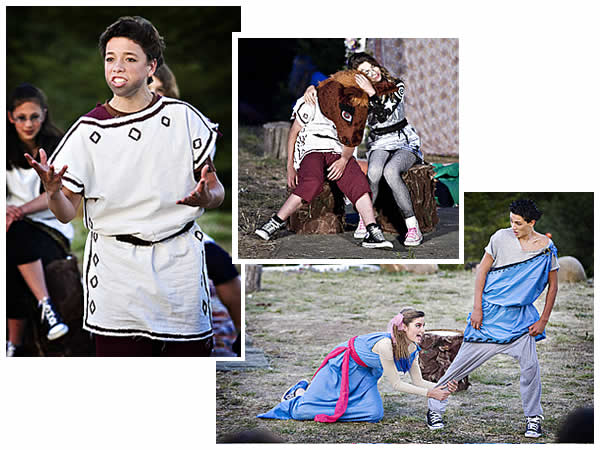
[photos courtesy of Lynne Owen Photography/NichePhoto Design]
It's funny how magic sometimes works its way into some of our kitchens and onto our dinner plates. Last week, a CSA member by the name of Jen wrote us about a wonderful experience: how despite her loathing of licorice she tried eating fennel anyway, and much to her surprise discovered a tasty and pleasurable food. Here is what she wrote:
“You guys sent me something I didn't want to even try. You see, I HATE, LOATHE, and DESPISE licorice. I don't like the flavor, I won't drink Ouzo, or any other anise flavored drinks. I pass black jelly beans on to my Mom or my Gram. Good and Plenty? You can keep 'em. BLEH!
“Then you sent fresh fennel. So then I finally had to put my money where my mouth is. Part of the idea behind getting your CSA box was to expose my family to new veggies and fruits and help us eat better. So I pulled out "Nourishing Traditions" by Sally Fallon, and looked up what she had for fennel. She had a very simple sliced fennel salad with a lemon pepper dressing, finished off with fresh parm. I had a bunch of radishes left as well, so I sliced them up on the mandoline too (I used the .75mm blade setting. Wafer thin!). Put some on everyone's plate. Then I sat down to eat my dinner. A tentative bite. Hey, this isn't half bad. Bigger bite. I can still taste the licorice, but the lemon and pepper flavors are covering it up a bit. Then I remembered the parm! I sprinkled some of that on. Ooo! This is good stuff! I ate my entire serving and went back for seconds. Discovered that letting the salad marinate a bit mellows out the licorice flavor. And it went over fairly well with the family too. One of my 2 year old twins asked for seconds as well. I don't think it will become a favorite vegetable, but at least we won't be dismayed to find some in our box again. I now know how to make something tasty with it.
“I just had to share this experience with you. Thanks for exposing us to new things.”
We love to hear members’ stories, and encourage everyone to tell us about their weekly food adventures. Some of you have been with us for several seasons, experienced good crops, bad crops, the ups and the downs, the pretty and the ugly, and of course numerous farm stories season after season. But many of you are just starting to receive our shares for the first time, and we hope it's a culinary adventure you enjoy. So let us know what's cooking and how the Farm's early season shares are fitting into your life.
– Tom
<back to top>
What's Up in the Field
~~~~~~~~~~~~~~~~~~~~~~~~~~~~~~~~~~~~~~~~~~~~~~~~
To give an update on the development of
different crops I'll let the pictures do the talking this week (see Pictures
Around the Farm, below).
The English peas in your shares this week are from Lakeside Organic Garden. You
may see some little spots on the outer pods, but this is just frost damage; totally
cosmetic... the peas inside are super sweet and wonderful! Sad to think they
were turned down by grocers because they were 'imperfect', but then again, lucky
for us, huh?
On a more scary note, one of our well pumps stopped working on Saturday; as I
write this newsletter I can only hope that Monday will be a luckier day to fix
whatever the problem is. It's always a bit nerve-wracking when crops – especially
our main strawberry patch – are without water.
<back to top>
Live Earth Farm Kids
~~~~~~~~~~~~~~~~~~~~~~~~~~~~~~~~~~~~~~~~~~~~~~~~
If you ever catch your kids in a great moment with Live Earth Farm veggies
or fruit, do send us pictures! Here is member Jennifer Chen's 2-year old
having a blast with fava beans...
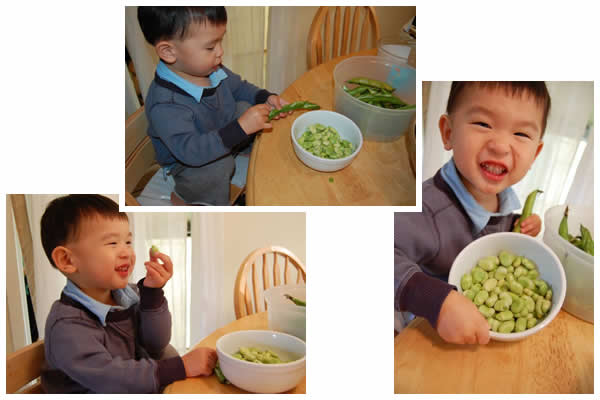
<back to top>
Mataganza Garden Sanctuary Open House and Fundraiser
~~~~~~~~~~~~~~~~~~~~~~~~~~~~~~~~~~~~~~~~~~~~~~~~
From resident permaculturalist, Brian Barth:
You are invited to the Mataganza
Garden Sanctuary Open House and Fundraiser, Sunday June 8th, 3-8 pm.
We Will:
-Enjoy Being in the Garden Together
-Learn About the Plants in the Garden
-Make Herbal Products, such as Tinctures, Essential Oils, Salves, Beauty Products,
Teas, Baked Goods and More to Help Support the Garden
-Take Home some of these Products to Help Support the Garden
-Enjoy a Potluck Dinner Together
If you would like to attend Please RSVP at edenfruits2002@yahoo.com
We will send out another e-mail closer to the event describing what you can
bring as a contribution to our product-making fundraiser party.
For More Information Please Contact Brian Barth at (831) 566-3336
or email
him at edenfruits2002@yahoo.com
If you would like more information on upcoming workshops and events
or about our internship program, please visit the 'Education,
Events, Programs' and '2008 Calendar of Events' sections of Live
Eath Farm's website.
<back to top>
Pictures around the farm
~~~~~~~~~~~~~~~~~~~~~~~~~~~~~~~~~~~~~~~~~~~~~~~~
This week, a tour of the fields:
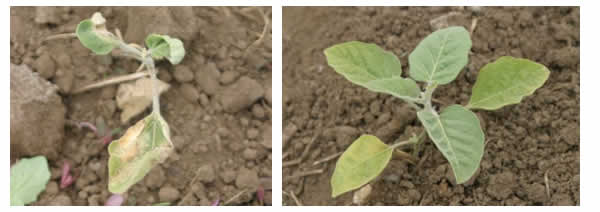
Above are two eggplant seedlings; the one at left was exposed to the
frost two weeks ago; at right, the healthy version, i.e. one kept safe
under the protective row cover 'blanket'.
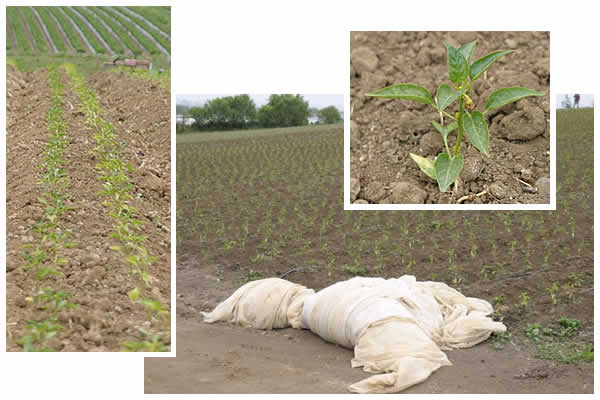
Here are fields of our pepper plant seedlings. Note the row cover 'blankets'
rolled up and on standby.
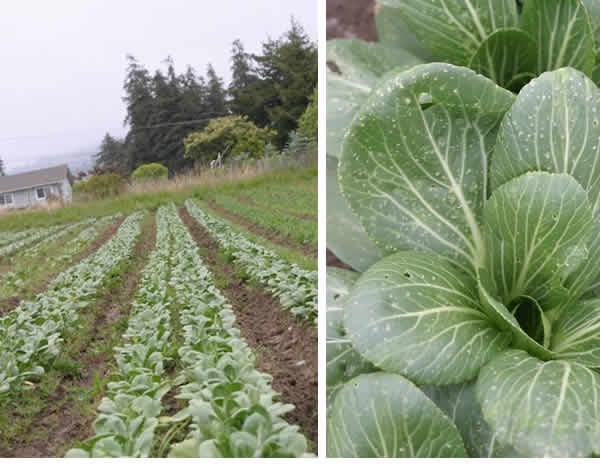
A field of mei qing choi. The fine holes in the leaves are from flea
beetles, which are out in force right now. Fortunately they are only
a cosmetic concern; the choi is unaffected flavor-wise. There are no
beetles on them when harvested, just the tiny holes they leave behind
[and isn't there a study out now, documenting how plants which have
to fend off pests themselves are naturally higher in nutrients/antioxidants
than those protected artificially by pesticides?].
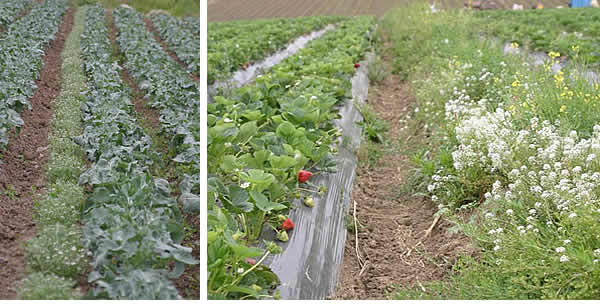 Speaking
of pest control, notice the sweet alyssum in between the rows of broccoli
(left) and, combined with alfalfa, every 10th row in the strawberry
fields. The alyssum and alfalfa both provide habitat for beneficial
insects (wasps that keep aphids in check), and draw away pests like
lygus bugs (they cause strawberry damage) which like the alfalfa
more than strawberries.
Speaking
of pest control, notice the sweet alyssum in between the rows of broccoli
(left) and, combined with alfalfa, every 10th row in the strawberry
fields. The alyssum and alfalfa both provide habitat for beneficial
insects (wasps that keep aphids in check), and draw away pests like
lygus bugs (they cause strawberry damage) which like the alfalfa
more than strawberries.
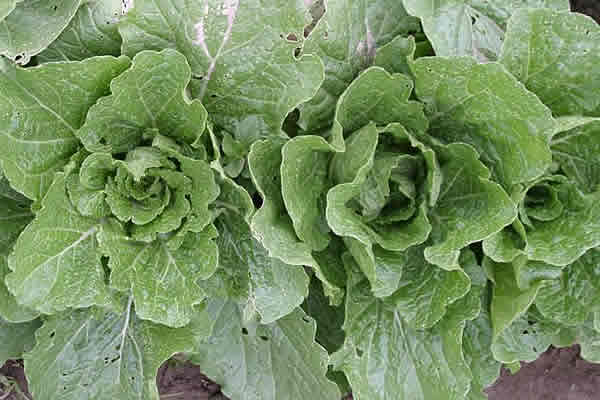
Some napa cabbage. . . note the heads just starting to form.
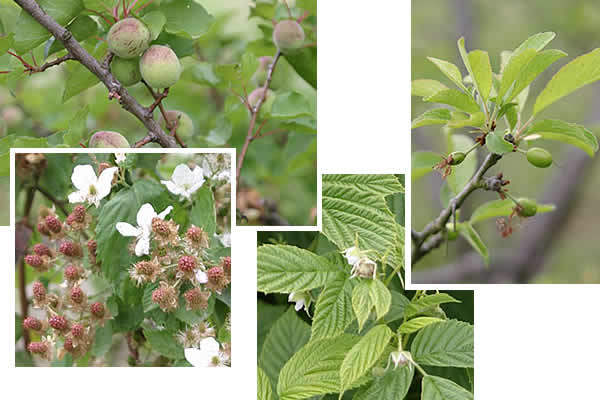
And last but not least, the fruit –
a preview of what's to come! Counterclockwise from top left: apricots,
blackberries, raspberries, and prune plums.
<back to top>
What's in the box this week
~~~~~~~~~~~~~~~~~~~~~~~~~~~~~~~~~~~~~~~~~~~~~~~~
Content differences between Family and Small
Shares are in red; items
with a “+” in
Family Shares are more in quantity than in Small; anticipated quantities, if
any, are in parentheses, as are the source of any produce if not from Live Earth
Farm (LEF). Occasionally content will differ
from this list (typically we will make a substitution), but we do our best to
give you an accurate projection.
Family Share:
Arugula (bagged)
Red beets (bunched, with greens) [next week!]
Cauliflower (Lakeside)
Fava
Beans +
Fennel, small heads, bunched
Green garlic,
bunched
Kale or Chard
Lettuce +
English peas!
Scallions
Radishes
Strawberries (see list in binder for final quantities)
Small Share:
Red beets (bunched, with greens) [next week!]
Cauliflower (Lakeside)
Fava
Beans
Fennel, small heads, bunched
Green garlic,
bunched
Lettuce
Mei
Qing Choi (bunched)
English peas!
Radishes
Strawberries (see list in binder for final quantities)
Extra Fruit Option:
probably3 baskets of strawberries, but go by what’s on the list
next to your name in the binder!
Bread Option:
for those of you who signed up for this option, it starts this week!
(for those of you who haven't signed up yet for this option but want
to,
email Debbie! We can still set you
up!)
<back to top>
Notes from Debbie's Kitchen
~~~~~~~~~~~~~~~~~~~~~~~~~~~~~~~~~~~~~~~~~~~~~~~~
Click
here to go to recipe database
New for everybody this week are cauliflower and
English peas (! a surprise, you’ll see, when you read below), and also
arugula (although that’s
only in the Family share). - Debbie
Cauliflower...you can eat it raw or cooked. When I was a kid, my mom would
serve raw florettes with cocktail sauce (catsup, lemon juice, horseradish) for
dipping, and I always liked it just fine. And I’ve had it steamed, and
in Indian curries and liked it that way too, but I have to say my favorite
way to eat it is roasted! I had never eaten it roasted until about 8 years
ago, and that was a watershed moment! My still current favorite roasted cauliflower
dish is North
African Roasted Cauliflower (<--recipe on website), but I found the
following in my clipping collection, and since we’re getting fennel again,
this sounded like a good one to try too:
Roasted Cauliflower with Onions and Fennel
from an undated Bon Appetit clipping [with minor edits!]
4 to 6 servings
1 medium head of cauliflower (about 1 ¼ lbs), cored, cut into 1-inch florets
Olive oil
2 medium onions, peeled, halved lengthwise, then cut into wedges [leave some
of the core attached to hold the wedges together]
2 fresh fennel bulbs [ours are small, you may want to use 3 or 4], halved lengthwise
and also cut into wedges [same deal about the core as with the onions]
8 small, unpeeled garlic cloves, unpeeled [or take a stalk or two of green garlic
and cut the green neck into segments]
15 fresh marjoram sprigs
Preheat oven to 425 degrees. Toss cauliflower with some olive oil in a large
bowl until lightly coated. Heat a heavy large skillet [cast iron is great for
this if you have it!] over medium-high heat; add cauliflower and sauté until
beginning to brown, about 5 minutes. Transfer to a rimmed baking sheet.
Add some more oil to the skillet and brown wedges on one side, about 3 minutes;
transfer carefully to baking sheet with cauliflower. Arrange wedges browned side
up.
Add bit more oil to pan, and do the same with the fennel, and then put with the
onion and cauliflower.
Scatter garlic* and marjoram over vegetables. Sprinkle with salt and pepper.
Roast in center of oven until vegetables are caramelized, about 25 minutes. Serve
hot or at room temperature.
*If you’re using chunks of green garlic, you might pan brown them on one
cut side like you did with the onions and fennel.
Arugula is great – I love arugula!! I prefer it raw over cooked,
but that’s just my own bias; you can definitely cook it (if I did, I’d
cook it minimally, just wilt it, really, maybe dress it with some olive oil
and use it as a bed under some chicken or fish). Try arugula the same way I
suggested you try the red mustards – the
same way I recommend tasting a lot of things really – that is, just
taste it raw and unadorned. It has a lovely, peppery bite. Tear it up and mix
it into your salad with the lettuces; toast some walnuts, throw ‘em in.
Thinly slice some of those scallions, add them. Slice up some strawberries,
add ‘em. Now
add some cheese... feta would be good, or chevre. Now toss everything with
a fruity
dressing (<--click here and scroll down to "Debbie's Salad Dressings")
and voila!
Meanwhile, here’s a recipe that Member Amoreena Lucero sent me last
week, saying the recipe just ‘popped into her head one day!’ We’re
getting all the parts this week, so... perfect timing! It sounds very similar
to the fennel recipe “Jan” talks about in Tom’s opening blurb,
so I think that bolsters the idea that this is a tasty combo!
Fennel, Radish and Spring Onion Salad
by Amoreena Lucero
As strange as this combination may sound, the sweetness of the fennel and the
zing of the radish balance each other. The addition of lemon juice enhances
the flavors of the vegetables. The quantities of this recipe depend entirely
on how many you are cooking for, and what portion size you desire. Basically,
you are looking for an equal ratio of each ingredient. The quantities below
are 2-3 “large” side servings. I use my mandolin for very thin
slices, making this a quick salad to put together.
Salad
1 med bulb of fennel, thinly sliced
3-4 large radishes
1 medium spring onion
Dressing
2-4 T lemon juice
1 T white wine vinegar
4 T extra virgin olive oil (to taste, as needed)
salt & fresh ground pepper
Mix the lemon juice and vinegar in a small bowl, adding the olive oil in a slow
stream while stirring quickly to emulsify. Adjust acid and oil as needed. Add
salt and pepper to taste, then set dressing aside.
Mix the salad ingredients in a large bowl, then toss with the dressing. Taste,
and add additional salt & pepper if needed. Serve!
Just to give you some idea of how quickly things
can change and how we/I need to be able to adapt accordingly... here I was
mid-way through preparing beet recipes for you (we were going to have beets
in this week’s shares)
when Tom called with a ‘this just in’ sort of bulletin: “Debbie!
We have this great opportunity to get some beautiful, sweet English peas from
Billy [that’s Billy Peixote, from Lakeside]. I was thinking of putting
them in this week’s shares instead of the beets, since the beets can
keep in the ground, but the peas will not be around next week... What do you
think? Oh, and by the way, have you already written beet recipes?” ;-)
So here is something I wrote back in 2004 about English peas; it still holds
water, so I’ll run it again! And I’ll save the beet recipe I was
preparing for next week!
What Debbie'd do with fresh peas
To be honest, unless we get peas for more than just a few weeks, I will
probably never make it beyond simply shelling and eating them raw. There is
nothing that compares to eating fresh, tender, raw green peas. They are so
sweet and delicious! And if you have children, shelling peas is a great way
for getting many hands involved. If we get enough of them over the weeks to
sate my eat-‘em-raw urge, then I’d use them in recipes where they
are cooked minimally. They can be tossed into pasta-and-cheese type dishes
near the end of cooking. Put ‘em raw into tuna salad, or other cold pasta
or rice salad-type dishes. That’s probably what I’ll do with my
peas. Below is a won-derful sounding fresh pea soup recipe from Deborah Madison
(famous vegetarian chef and cookbook author, if you haven’t heard of
her), that utilizes the pods in making the broth. I like the sound of that!
Elixir of Fresh Peas
serves 4 to 6 as a first course
Chef Deborah Madison says, "This pale green froth of a soup is the essence
of fresh peas. Peas can travel in every flavor direction imaginable, but this
soup needs nothing, although a few drops of truffle oil are intriguing. Plan
to make it just before you serve it, unless you want to serve it chilled. The
light, fragrant stock is made while you shuck the peas, and cooking time for
the soup is about 4 minutes."
1 bunch scallions or 2 small leeks, incl. 2" of the greens, thinly sliced
5 lg. parsley stems, with leaves
Salt and white pepper*
1 1/2 lbs. fresh English pod peas
1 tsp. unsalted butter
1/2 C thinly sliced fresh onions [we got those this week!] or young leeks
1/2 tsp. sugar
Truffle oil, a few drops per bowl [I deduce, based on her quote above, that this
would be optional!]
Bring 1 qt. water to a boil. As it's heating, add the scallions, parsley, and
1/2 tsp. salt. Add about 3 C of pea pods as you shell them. Once the water comes
to a boil, lower the heat. Simmer for 20 minutes, then strain. [i.e. strain out
and toss the veggies; keep the stock!]
Melt butter in a soup pot and add sliced onion. Cook over medium heat about a
minute, then add 1/2 C of the stock so that the onions stew without browning.
After 4 to 5 minutes, add the peas, 1/2 tsp. salt, and the sugar. Pour in 2 1/2
C of the stock, bring to a boil, and simmer for 3 minutes.
Transfer soup to a blender. Drape a towel over the lid, and give a few short
pulses to make sure it won't splatter [remember my past lectures about hot stuff
in blenders and heed her warning!]. Then puree at high speed for 1 minute. Pour
into small soup bowls and serve immediately, adding a few drops of truffle oil
to each bowl [optionally].
*I noticed (when making this recipe for dinner tonight 7/5/04) that everywhere
I found this recipe online, the preparation instructions neglected to tell you
to add the white pepper anywhere! So anyway, I just added a dash along with the
peas in the last cooking step before pureeing. Just a bit goes a long way!
And the Small Shares are getting bok ch--, er,
mei qing choi again (Tom always just calls it bok choi), so here’s another
recipe for that which sounded good:
Ginger garlic baby bok choy
from an undated SJ Mercury news clipping,
recipe ‘adapted from Martin
Yan’s “Martin Yan’s China”’
serves 4
1 lb baby bok choy [remember, mei qing choi is totally interchangeable!]
1 ¼ tsp salt, divided use
2 tbsp rice wine vinegar or dry sherry
2 tsp oyster sauce
1 tsp soy sauce
1 tbsp vegetable oil
1 tbsp minced garlic [double that minced green garlic]
1 tbsp minced ginger
3 small dried red chilies
Bring medium saucepan of water to boil. Fill large bowl with cold water. Trim
ends of bok choy, separating and rinsing the leaves.
Add 1 tsp salt and bok choy to water in saucepan. Blanch bok choy for 1 minute,
or until bright green [I’d say less than a minute!! 30 seconds at most].
Use slotted spoon to transfer choy to cold water. Let them cool briefly, then
drain and set aside.
In small bowl, whisk together rice wine, oyster sauce, soy sauce and remaining
salt. Set sauce aside.
In large skillet, heat oil over high, swirling pan to coat sides. Add garlic,
ginger and chilies and sauté until fragrant, about 10 seconds. Add bok
choy and sauce and sauté until the liquid has reduced by half, about 1
to 2 minutes.
And lastly, if you’re looking for more
ideas of ways to use Fava Beans, here’s some info from two years ago,
sent me by another CSA member:
Barbie Aknin's Ideas for using Fava Beans
Barbie says, “Hi Debbie, I have to share a few ideas with you for
my favorite veggie... fava beans. My kids eat them like peanuts, blanched and
cold. My father-in-law is from France and this is what he does: Blanch the
fava beans until just tender. Rinse in cold water and drain well. Drizzle abundantly
with olive oil; sprinkle with course sea salt, a little minced garlic and "Herbs
de Provence." If you don't have them, I like fresh minced thyme and grated
lemon rind. These will last in the fridge for 3 to 4 days. He serves them with
a good white wine and toothpicks before dinner. I throw them in pasta or smash
them and spread on toasted baguette.”
<back to top>
2008 Calendar of Events
~~~~~~~~~~~~~~~~~~~~~~~~~~~
For details on events listed
below, please Click
here to go to the calendar page on our website.
Santa Cruz Permaculture Design course - one weekend/month for
6 months, Feb-July
Spring "Six Thursdays" Mataganza Garden Internship - every
Thursday from May 1st through June 5th, 10am - 5pm, in the Mataganza
Garden Sanctuary at Live Earth Farm.
Herbalism Classes at Live Earth Farm:
<>Herbal First Aid - March 15-16
<>Medicine Making - May 10-11
<> Cooking with Herbs - July 19-20
Summer Solstice Celebration - Saturday June 21st
Children's Mini-Camp - July 11th - 13th (Friday evening thorugh Sunday
noon)
Fall Equinox Cob Building Workshop and Campout - Sept. 20 and 21
Fine Farm Feast - Oct 4th
Fall Harvest Celebration - later in October (date TBA)
Contact Information
~~~~~~~~~~~~~~~~~~~~~~~~~~~
email Debbie at the farm (for any farm or CSA share-related business): farmers@cruzio.com
email Debbie at home (with newsletter input or recipes): deb@writerguy.com
farm phone: 831.763.2448
website: http://www.liveearthfarm.net
~~~~~~~~~~~~~~~~~~~~~~~~~~~